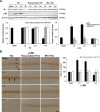Down-regulation of cyclin-dependent kinase 5 attenuates p53-dependent apoptosis of hippocampal CA1 pyramidal neurons following transient cerebral ischemia
- PMID: 31506563
- PMCID: PMC6737192
- DOI: 10.1038/s41598-019-49623-x
Down-regulation of cyclin-dependent kinase 5 attenuates p53-dependent apoptosis of hippocampal CA1 pyramidal neurons following transient cerebral ischemia
Abstract
Abnormal activation of cyclin-dependent kinase 5 (Cdk5) is associated with pathophysiological conditions. Ischemic preconditioning (IPC) can provide neuroprotective effects against subsequent lethal ischemic insult. The objective of this study was to determine how Cdk5 and related molecules could affect neuroprotection in the hippocampus of gerbils after with IPC [a 2-min transient cerebral ischemia (TCI)] followed by 5-min subsequent TCI. Hippocampal CA1 pyramidal neurons were dead at 5 days post-TCI. However, treatment with roscovitine (a potent inhibitor of Cdk5) and IPC protected CA1 pyramidal neurons from TCI. Expression levels of Cdk5, p25, phospho (p)-Rb and p-p53 were increased in nuclei of CA1 pyramidal neurons at 1 and 2 days after TCI. However, these expressions were attenuated by roscovitine treatment and IPC. In particular, Cdk5, p-Rb and p-p53 immunoreactivities in their nuclei were decreased. Furthermore, TUNEL-positive CA1 pyramidal neurons were found at 5 days after TCI with increased expression levels of Bax, PUMA, and activated caspase-3. These TUNEL-positive cells and increased molecules were decreased by roscovitine treatment and IPC. Thus, roscovitine treatment and IPC could protect CA1 pyramidal neurons from TCI through down-regulating Cdk5, p25, and p-p53 in their nuclei. These findings indicate that down-regulating Cdk5 might be a key strategy to attenuate p53-dependent apoptosis of CA1 pyramidal neurons following TCI.
Conflict of interest statement
The authors declare no competing interests.
Figures







Similar articles
-
Roles of HIF-1α, VEGF, and NF-κB in Ischemic Preconditioning-Mediated Neuroprotection of Hippocampal CA1 Pyramidal Neurons Against a Subsequent Transient Cerebral Ischemia.Mol Neurobiol. 2017 Nov;54(9):6984-6998. doi: 10.1007/s12035-016-0219-2. Epub 2016 Oct 26. Mol Neurobiol. 2017. PMID: 27785755
-
Tumor necrosis factor receptor 2 is required for ischemic preconditioning-mediated neuroprotection in the hippocampus following a subsequent longer transient cerebral ischemia.Neurochem Int. 2018 Sep;118:292-303. doi: 10.1016/j.neuint.2018.05.008. Epub 2018 May 17. Neurochem Int. 2018. PMID: 29777731
-
Effects of ischemic preconditioning on VEGF and pFlk-1 immunoreactivities in the gerbil ischemic hippocampus after transient cerebral ischemia.J Neurol Sci. 2014 Dec 15;347(1-2):179-87. doi: 10.1016/j.jns.2014.09.044. Epub 2014 Oct 2. J Neurol Sci. 2014. PMID: 25300771
-
Effects of ischemic preconditioning on PDGF-BB expression in the gerbil hippocampal CA1 region following transient cerebral ischemia.Mol Med Rep. 2017 Aug;16(2):1627-1634. doi: 10.3892/mmr.2017.6799. Epub 2017 Jun 19. Mol Med Rep. 2017. PMID: 28627606 Free PMC article.
-
Interplay between the p53 tumor suppressor protein family and Cdk5: novel therapeutic approaches for the treatment of neurodegenerative diseases using selective Cdk inhibitors.Mol Neurobiol. 2006 Aug;34(1):27-50. doi: 10.1385/mn:34:1:27. Mol Neurobiol. 2006. PMID: 17003520 Review.
Cited by
-
Protein Kinase C-Delta Mediates Cell Cycle Reentry and Apoptosis Induced by Amyloid-Beta Peptide in Post-Mitotic Cortical Neurons.Int J Mol Sci. 2024 Sep 5;25(17):9626. doi: 10.3390/ijms25179626. Int J Mol Sci. 2024. PMID: 39273571 Free PMC article.
-
The role of Cdk5 in neurological disorders.Front Cell Neurosci. 2022 Jul 28;16:951202. doi: 10.3389/fncel.2022.951202. eCollection 2022. Front Cell Neurosci. 2022. PMID: 35966199 Free PMC article. Review.
-
The alpha2-adrenergic receptor agonist clonidine protects against cerebral ischemia/reperfusion induced neuronal apoptosis in rats.Metab Brain Dis. 2024 Jun;39(5):741-752. doi: 10.1007/s11011-024-01354-3. Epub 2024 Jun 4. Metab Brain Dis. 2024. PMID: 38833094
-
Mitochondrial-nuclear p53 trafficking controls neuronal susceptibility in stroke.IUBMB Life. 2021 Mar;73(3):582-591. doi: 10.1002/iub.2453. Epub 2021 Mar 2. IUBMB Life. 2021. PMID: 33615665 Free PMC article. Review.
-
Unveiling Potential Neurotoxic Mechansisms: Pb-Induced Activation of CDK5-p25 Signaling Axis in Alzheimer's Disease Development, Emphasizing CDK5 Inhibition and Formation of Toxic p25 Species.Mol Neurobiol. 2024 May;61(5):3090-3103. doi: 10.1007/s12035-023-03783-0. Epub 2023 Nov 16. Mol Neurobiol. 2024. PMID: 37968421
References
Publication types
MeSH terms
Substances
LinkOut - more resources
Full Text Sources
Medical
Molecular Biology Databases
Research Materials
Miscellaneous

